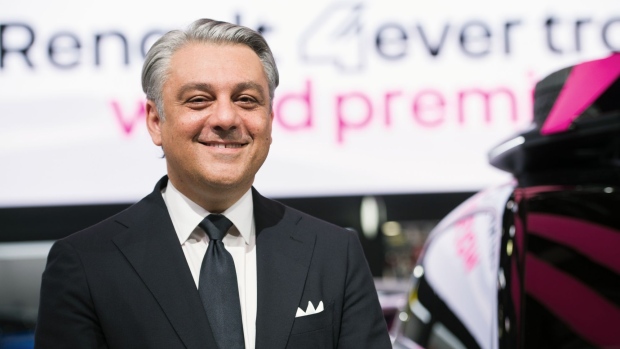Nov 8, 2022
Renault to Boost Returns in Split Plan With Outside Investors
, Bloomberg News

(Bloomberg) -- Renault SA plans plans to boost its profitability and reinstate its dividend as the French carmaker proceeds with a complex split of its electric-vehicle and combustion-engine businesses, backed by outside investors.
The manufacturer, whose mainstay is the highly competitive European market, is seeking an operating margin of more than 10% by 2030, up from more than 5% this year, Renault said Tuesday, ahead of the start of an investor day that comes as complex talks with partner Nissan Motor Co. continue. Dividend payments will resume next year as turnaround efforts take hold.
The shares declined as much as 3.5% in early trading in Paris, trimming gains this year.
Chief Executive Officer Luca de Meo, who took over in July 2020 just before Renault reported a record loss, has embarked on a radical overhaul of operations as the carmaker seeks to navigate the difficult and costly transition to electrification. The move to separate operations is expected to help Renault raise funds for EV development and technology and narrow the gap with bigger companies such as Stellantis NV, the maker of Jeep SUVs.
Renault’s financial targets “appear far more ambitious than what we were expecting,” RBC analyst Tom Narayan said in a note. The plan raises a number of questions, according to the analyst, including how to separate the EV and Power businesses that share some operations and achieving breakeven levels amidst battery cost inflation.
By 2025, Renault is forecasting an operating margin above 8% with free cash flow of more than €2 billion annually on average through then, the company said. The maker of the electric Megane E-Tech cars also outlined a dividend policy set to grow “gradually” and “in a disciplined manner” to a payout ratio of as much as 35% of net income in the mid term, it said.
Five Groups
Under the plans unveiled Tuesday, Renault is reorganizing into five different units spanning electric cars, combustion- and hybrid-engine assets, the Alpine sports-car brand, financial services and new mobility and recycling businesses.
The move follows other carmakers taking unprecedented steps to adapt to challenges posed by the EV transition. Ford Motor Co. in March said it’ll separate the fast-growing EV and software business from the combustion-engine assets that will focus on cutting costs and streamlining operations. Last year, Daimler ended more than a century of making cars and trucks under one roof, with Mercedes-Benz Group AG and Daimler Truck Holding AG now listed separately.
At Renault, the two most important steps relate to its EV and combustion-car divisions, named Ampere and Power.
For Ampere, the company is seeking external investors. It’s also weighing an initial public offering on Euronext Paris in the second part of 2023, at the earliest. Renault plans to keep a “strong majority” in Ampere and is counting on the support of potential cornerstore investors, such as Qualcomm Inc.
Renault, an early mover in EVs with the fully-electric Zoe, is aiming for a roughly €10 billion valuation for Ampere, people familiar with the situation have said. The business will have a lineup of six electric cars before the end of the decade and plans to make about 1 million EVs annually for the Renault brand by 2031.
That valuation would top Renault’s current market value of €9.4 billion. The target is aspirational and the IPO will be subject to market conditions, the people said.
Tense Talks
Renault’s carve-out push has been at the heart of tense talks with Japanese partner Nissan Motor Co. this year as the two companies seek to reshape a two-decade-old alliance that’s been problematic since the 2018 arrest of former leader Carlos Ghosn.
The talks are ongoing, Renault said today, without elaborating. The valuation of Ampere has been among sticking points in the discussions, which also hit snags over intellectual property concerns, people familiar with the talks have said.
The company is also combining its legacy combustion-engine and hybrid powertrain business with China’s Zheijiang Geely Holding Group in a major push to save costs. Renault will retain a 50% stake in the new entity with combined revenue of more than €15 billion with Geely owning the other half. The unit will employ 19,000 employees across three continents with 17 plants.
Alpine Plans
The carmaker is also pushing to broaden the appeal of its boutique Alpine sports-car brand. The maker of the A110 sports coupe is set to develop a new line-up to include hatchback and crossover models, as well as targeting further segments. Renault expects half of Alpine’s growth -- the unit sold 784 cars during the third quarter -- to come from new markets including potentially North America and China.
Renault in July raised its 2022 operating margin outlook to above 5% in July after turnaround efforts started talking hold.
Renault’s New Targets
- Operating margin +8% in 2025, +10% in 2030
- Free cash-flow above €2 billion per year on average over 2023-2025, above €3 billion per year on average over 2026-2030
- Restore dividend from 2023; plan to raise payout ratio gradually to as much as 35% of net income in mid-term
- Dividend plan hinges on Renault returning to investment grade rating
- Ampere EV business to beak even in 2025, around 10% operating margin in 2030
- Alpine brand to generate €2 billion in revenue in 2026, more than €8 billion in 2030 with break even targeted for 2026
(Updates with shares in third, analyst comment fifth paragraph)
©2022 Bloomberg L.P.





